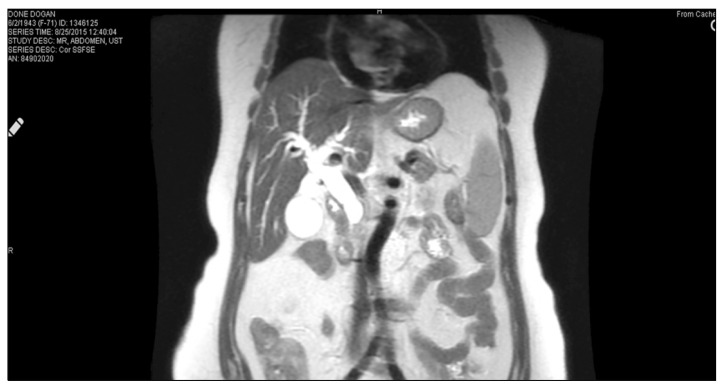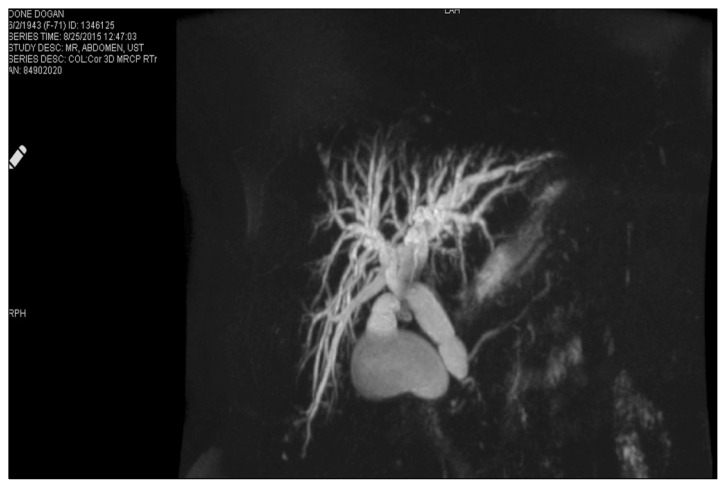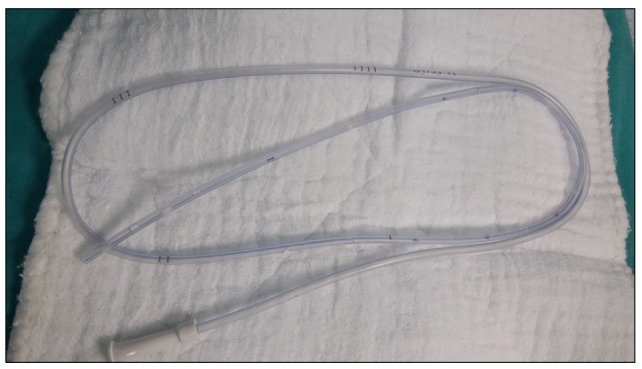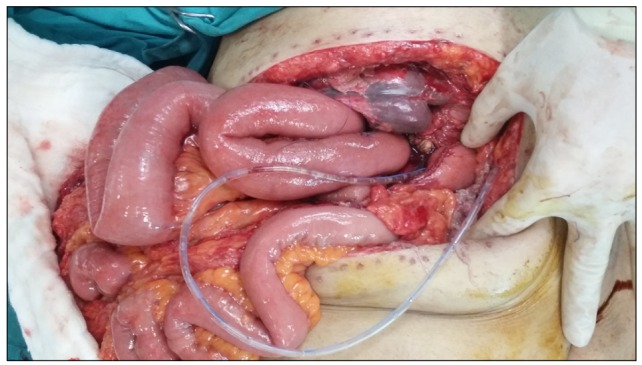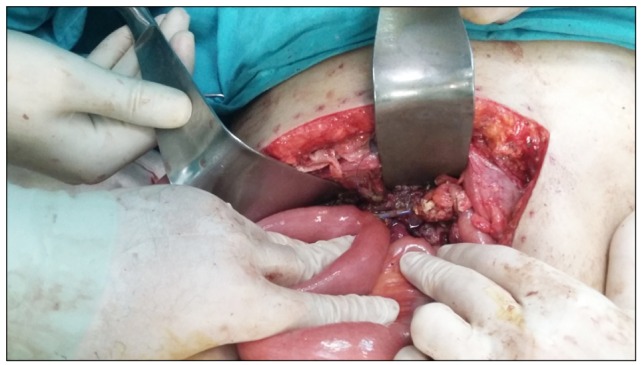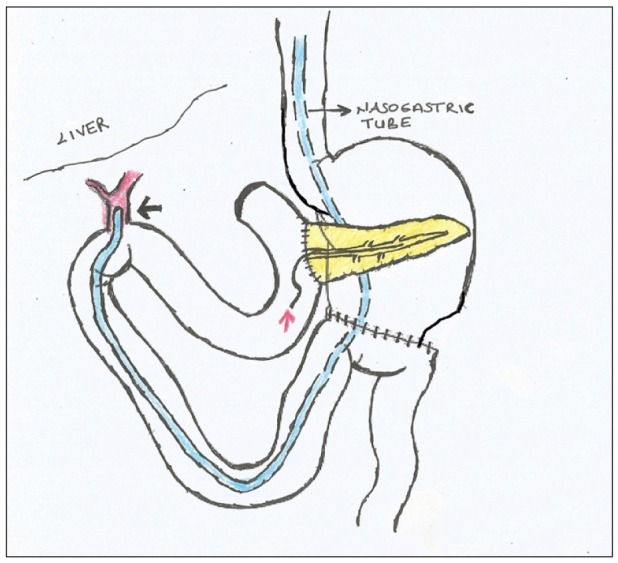Korean J Hepatobiliary Pancreat Surg.
2016 May;20(2):89-92. 10.14701/kjhbps.2016.20.2.89.
Nasogastric tube placement into the hepaticojejunostomy anastomosis in pancreaticoduodenectomy: a simple surgical technique for prevention of bile leak
- Affiliations
-
- 1Department of General Surgery, Fatih Sultan Mehmet Training and Research Hospital, Atasehir-Ä°stanbul, Turkey. drbkaya@yahoo.com
- KMID: 2243022
- DOI: http://doi.org/10.14701/kjhbps.2016.20.2.89
Abstract
- Hepaticojejunostomy is an important part of many surgical procedures including pancreaticoduodenectomy. Biliary leakage from hepaticojejunostomy may be associated with intraabdominal abscess formation, biliary peritonitis, and even mortality. A 72-year-old female patient was admitted to our hospital with obstructive jaundice. After initial evaluation, she was diagnosed with distal common bile duct obstruction without accurate diagnosis. Before planned pancreaticoduodenectomy, biliary drainage with a T-tube was performed due to the presence of cholangitis. After the first operation, pancreaticoduodenectomy was performed. Postinflammatory changes around the hilar region made the hepaticojejunostomy risky. A bilio-digestive anastomosis was performed using a new technique. A nasogastric tube was placed into the common bile duct proximal to the anastomosis. The postoperative course of the patient was uneventful. The use of a nasogastric tube as a stent in risky hepaticojejunostomies is a simple technique that can be beneficial.
MeSH Terms
Figure
Cited by 1 articles
-
Percutaneous trans-hepatic rescue and neo-creation of a post-surgical complete hepaticojejunostomy dehiscence
Umberto Geremia Rossi, Andrea DeCensi, Gian Andrea Rollandi, Marco Filauro
Ann Hepatobiliary Pancreat Surg. 2021;25(3):386-389. doi: 10.14701/ahbps.2021.25.3.386.
Reference
-
1. Winter JM, Cameron JL, Campbell KA, Arnold MA, Chang DC, Coleman J, et al. 1423 pancreaticoduodenectomies for pancreatic cancer: a single-institution experience. J Gastrointest Surg. 2006; 10:1199–1210. PMID: 17114007.
Article2. Yeo CJ. The Whipple procedure in the 1990s. Adv Surg. 1999; 32:271–303. PMID: 9891749.3. Grobmyer SR, Pieracci FM, Allen PJ, Brennan MF, Jaques DP. Defining morbidity after pancreaticoduodenectomy: use of a prospective complication grading system. J Am Coll Surg. 2007; 204:356–364. PMID: 17324768.
Article4. Balcom JH 4th, Rattner DW, Warshaw AL, Chang Y, Fernandez-del Castillo C. Ten-year experience with 733 pancreatic resections: changing indications, older patients, and decreasing length of hospitalization. Arch Surg. 2001; 136:391–398. PMID: 11296108.5. de Castro SM, Kuhlmann KF, Busch OR, van Delden OM, Laméris JS, van Gulik TM, et al. Incidence and management of biliary leakage after hepaticojejunostomy. J Gastrointest Surg. 2005; 9:1163–1171. PMID: 16269388.6. Antolovic D, Koch M, Galindo L, Wolff S, Music E, Kienle P, et al. Hepaticojejunostomy--analysis of risk factors for postoperative bile leaks and surgical complications. J Gastrointest Surg. 2007; 11:555–561. PMID: 17394045.
Article7. Herzog T, Belyaev O, Bakowski P, Chromik AM, Janot M, Suelberg D, et al. The difficult hepaticojejunostomy after pancreatic head resection: reconstruction with a T tube. Am J Surg. 2013; 206:578–585. PMID: 23906984.
Article8. Suzuki H, Shimura T, Mochhida Y, Wada S, Araki K, Kubo N, et al. To stent or not to stent hepaticojejunostomy--analysis of risk factors for postoperative bile leaks and surgical complication. Hepatogastroenterology. 2014; 61:920–926. PMID: 26158142.
- Full Text Links
- Actions
-
Cited
- CITED
-
- Close
- Share
- Similar articles
-
- Impact of nasogastric tube exclusion after minimally invasive esophagectomy for esophageal cancer: a single-center retrospective study in India
- Role of Endoscopic Vacuum Therapy as a Treatment for Anastomosis Leak after Esophageal Cancer Surgery
- Anterior pancreatic duct split prior to duct-to-mucosa pancreatico-jejunal anastomosis in pancreaticoduodenectomy
- The Insertion of a Nasogastric Tube with a Nasopharyngeal Airway
- Is routine nasogastric tube insertion necessary in pancreaticoduodenectomy?

